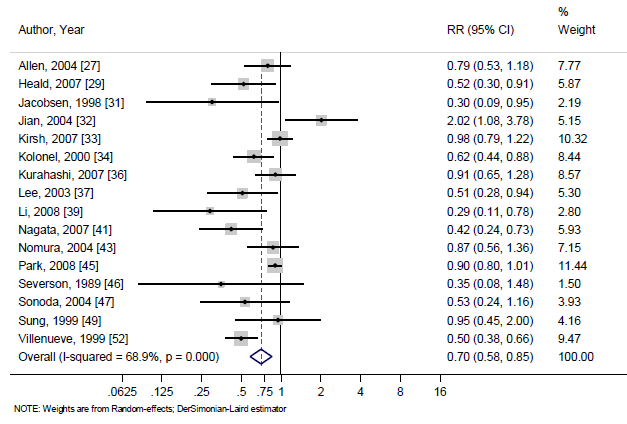
Comment:
comment here
Summary:
Clinical Bottom Line
This meta-analysis of observational studies suggests a significant association between higher consumption of soy foods and a reduced risk of prostate cancer. Specifically, total soy intake (RR 0.71), unfermented soy (RR 0.65), and dietary isoflavones genistein and daidzein were linked to lower risk. However, this finding should be interpreted with caution. The evidence is limited to observational data, and the analysis showed substantial heterogeneity between studies. Notably, no significant association was found for fermented soy foods, circulating isoflavone levels, or the risk of advanced prostate cancer.
Results
Summary of Results
This analysis pooled data from 30 observational studies. The main findings are:
-
Total Soy Food Intake: The pooled analysis of 16 studies found that the highest intake of total soy foods was associated with a 29% reduction in the relative risk of prostate cancer (Pooled Relative Risk [RR]: 0.71, 95% CI: 0.58–0.85).
-
Soy Type:
-
Unfermented Soy (e.g., soy milk, tofu): Associated with a reduced risk (Pooled RR: 0.65, 95% CI: 0.56–0.83).
-
Fermented Soy (e.g., miso): Showed no statistically significant association with risk (Pooled RR: 0.86, 95% CI: 0.66–1.13).
-
-
Dietary Isoflavones: Intake of the specific isoflavones genistein (Pooled RR: 0.90, 95% CI: 0.84–0.97) and daidzein (Pooled RR: 0.84, 95% CI: 0.73–0.97) was associated with a small but significant reduction in risk.
-
Circulating Isoflavones: No significant association was found between circulating blood levels of genistein or daidzein and prostate cancer risk.
-
Advanced Prostate Cancer: In the few studies that reported on advanced-stage disease, neither total soy intake nor isoflavone levels were associated with a reduced risk.
Assertive Critical Appraisal
Certainty of Evidence (GRADE Framework)
The authors did not use the GRADE framework; however, it is critical to note that this meta-analysis is based exclusively on observational studies (case-control, cohort, and nested case-control). This type of evidence can identify associations but cannot prove causation due to the inherent risk of unmeasured confounding variables. The overall certainty of this evidence is low.
Heterogeneity
The authors identified heterogeneity using the I2 statistic, which represents the percentage of variation across studies due to real differences rather than just chance.
-
The analysis for the primary outcome (total soy intake) showed high heterogeneity ( I2 = 68.9% ).
-
High heterogeneity was also seen for unfermented soy (I2 = 60.3%), fermented soy (I2 = 66.6%), and circulating genistein (I2 = 76.8%).
This substantial heterogeneity indicates that the included studies had widely different results, which weakens the confidence in the pooled average. The authors appropriately used a random-effects model to account for this.
Publication Bias
The authors assessed for publication bias using funnel plots and statistical tests (Egger’s and Begg’s).
-
For the total soy intake outcome, the tests were not significant, suggesting a low risk of publication bias.
-
However, for the dietary genistein and daidzein analyses, the tests were statistically significant. This suggests a risk of publication bias, where smaller, negative studies may be missing from the literature. This bias can lead to an overestimation of a treatment or exposure’s effect.
Risk of Bias in Included Studies
Study quality was assessed using the Newcastle-Ottawa Scale. The 15 cohort and nested case-control studies had an average “high quality” score (7.73/9), while the 15 case-control studies had a “medium-to-high quality” score (6.93/9). While generally good, case-control studies are inherently more susceptible to recall bias, which is a key limitation when assessing dietary intake.
Reporting Quality Assessment (PRISMA)
The review’s reporting quality is high. The authors adhered to PRISMA guidelines, included a complete PRISMA flow diagram showing the screening and selection of 30 studies from an initial 3,356 articles, and provided a clear description of their database search strategy. This enhances the transparency and reproducibility of the review.
Research Objective
The objective was to conduct an updated systematic review and meta-analysis of observational studies to evaluate the association between soy consumption and prostate cancer risk.
-
Population: Men at risk for or diagnosed with prostate cancer.
-
Intervention/Exposure: Soy food intake (total, unfermented, fermented), dietary isoflavone (genistein, daidzein) intake, and circulating isoflavone levels.
-
Comparator: Lower or no consumption/levels of soy or isoflavones.
-
Outcome: Risk of prostate cancer, including advanced-stage disease.
Study Design
This is a systematic review and meta-analysis of observational studies, following PRISMA and MOOSE guidelines. The authors searched PubMed, Web of Science, and the Cochrane Library for studies published up to May 2017. They included cohort, case-control, and nested case-control studies that reported a relative risk ratio and 95% confidence interval for the association between soy and prostate cancer risk.1
Setting and Participants
-
Studies: 30 articles were included in the meta-analysis.
-
Study Types: 15 case-control studies, 8 cohort studies, and 7 nested case-control studies.
-
Participants: The analysis included a total of 266,699 participants.
-
Cases: A total of 21,612 prostate cancer cases were reported across the studies.
-
Locations: Studies were from Asia (12), North America (10), and Europe (8).
Bibliographic Data
-
Title: Soy Consumption and the Risk of Prostate Cancer: An Updated Systematic Review and Meta-Analysis
-
Authors: Catherine C. Applegate, Joe L. Rowles III, Katherine M. Ranard, Sookyoung Jeon, and John W. Erdman Jr
-
Journal: Nutrients
-
Year: 2018
-
DOI: 10.3390/nu10010040
Mandatory Disclaimer: This AI-generated analysis is for informational and research purposes only and is not a substitute for professional medical advice, diagnosis, or treatment. Always seek the advice of a qualified health provider with any questions you may have regarding a medical condition.
Original Article:
Full text pdf: Soy Consumption and the Risk of Prostate Cancer An Updated Systematic Review and Meta-Analysis
© 2018 by the authors. Licensee MDPI, Basel, Switzerland. This article is an open access article distributed under the terms and conditions of the Creative Commons Attribution (CC BY) license (http://creativecommons.org/licenses/by/4.0/).
